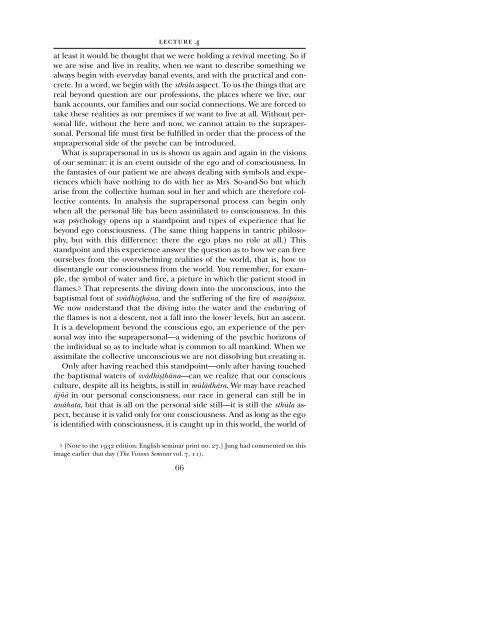CG JUNG - Countryside Anarchist
CG JUNG - Countryside Anarchist
CG JUNG - Countryside Anarchist
You also want an ePaper? Increase the reach of your titles
YUMPU automatically turns print PDFs into web optimized ePapers that Google loves.
LECTURE 4<br />
at least it would be thought that we were holding a revival meeting. So if<br />
we are wise and live in reality, when we want to describe something we<br />
always begin with everyday banal events, and with the practical and concrete.<br />
In a word, we begin with the sthÖla aspect. To us the things that are<br />
real beyond question are our professions, the places where we live, our<br />
bank accounts, our families and our social connections. We are forced to<br />
take these realities as our premises if we want to live at all. Without personal<br />
life, without the here and now, we cannot attain to the suprapersonal.<br />
Personal life must first be fulfilled in order that the process of the<br />
suprapersonal side of the psyche can be introduced.<br />
What is suprapersonal in us is shown us again and again in the visions<br />
of our seminar: it is an event outside of the ego and of consciousness. In<br />
the fantasies of our patient we are always dealing with symbols and experiences<br />
which have nothing to do with her as Mrs. So-and-So but which<br />
arise from the collective human soul in her and which are therefore collective<br />
contents. In analysis the suprapersonal process can begin only<br />
when all the personal life has been assimilated to consciousness. In this<br />
way psychology opens up a standpoint and types of experience that lie<br />
beyond ego consciousness. (The same thing happens in tantric philosophy,<br />
but with this difference: there the ego plays no role at all.) This<br />
standpoint and this experience answer the question as to how we can free<br />
ourselves from the overwhelming realities of the world, that is, how to<br />
disentangle our consciousness from the world. You remember, for example,<br />
the symbol of water and fire, a picture in which the patient stood in<br />
flames. 5 That represents the diving down into the unconscious, into the<br />
baptismal font of svvdhiü°hvna, and the suffering of the fire of maõipÖra.<br />
We now understand that the diving into the water and the enduring of<br />
the flames is not a descent, not a fall into the lower levels, but an ascent.<br />
It is a development beyond the conscious ego, an experience of the personal<br />
way into the suprapersonal—a widening of the psychic horizons of<br />
the individual so as to include what is common to all mankind. When we<br />
assimilate the collective unconscious we are not dissolving but creating it.<br />
Only after having reached this standpoint—only after having touched<br />
the baptismal waters of svvdhiü°hvna—can we realize that our conscious<br />
culture, despite all its heights, is still in mÖlvdhvra. We may have reached<br />
vjñv in our personal consciousness, our race in general can still be in<br />
anvhata, but that is all on the personal side still—it is still the sthÖla aspect,<br />
because it is valid only for our consciousness. And as long as the ego<br />
is identified with consciousness, it is caught up in this world, the world of<br />
5 [Note to the 1932 edition: English seminar print no. 27.] Jung had commented on this<br />
image earlier that day (The Visions Seminar vol. 7, 11).<br />
66


